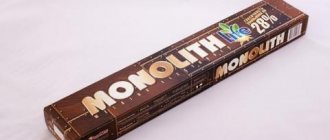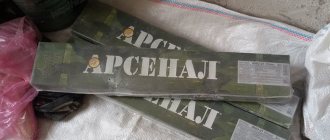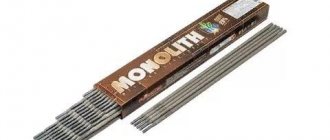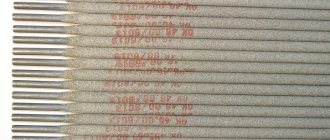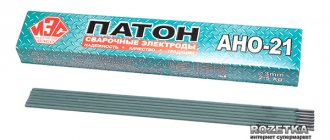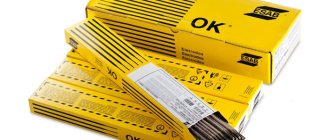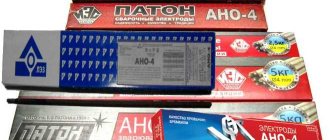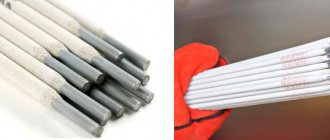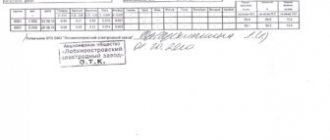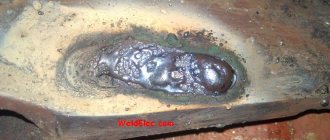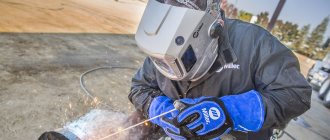| Tensile strength, N/mm2 | Relative extension, % | Impact strength, J/cm2 |
| ≥450 | ≥22 | ≥78 |
Special properties
A distinctive feature of MONOLITH RC products is the low intensity of aerosol and manganese formation during welding. Thanks to this, the product compares favorably with other brands of electrodes. The developers managed to achieve this result through the correct selection of raw materials and careful control over the technological and production process.
High quality indicators have been repeatedly noted by the country's leading scientific institutes. It is the MONOLITH RC electrodes that produce 30% less manganese and 28% less harmful substances in the aerosol.
MONOLITH RC products provide easy initial and re-ignition, as well as stable and soft arc burning. When using electrodes of this brand, it is possible to reduce metal loss due to spattering. It is possible to achieve excellent weld quality, uniform melting of the coating and good separability of the slag crust.
When using MONOLITH RC electrodes, welding can be carried out even at extremely low currents. If we are talking about using products of small diameter, then an ordinary household network can become a power source for them.
The electrodes are very easy to handle. Even young specialists can work with them.
When bending the electrode, the coating does not break. For this reason, they are convenient to use for welding in hard-to-reach places.
The products can be used when connecting metal to painted, oily and oxidized surfaces.
Welding modes
| Welding current strength (A), for electrode diameter, mm | |||||
| 2,0 | 2,5 | 3,0 | 3,2 | 4,0 | 5,0 |
| 40-80 | 50-90 | 70-110 | 80-120 | 110-170 | 150-220 |
For welding, it is allowed to use direct current of any polarity (the desired polarity of the electrode is reverse “+”, or alternating current of a transformer with an open circuit voltage of more than 50 V.)
Packaging details
| Diameter, mm | Length, mm | Number of electrodes in a pack, pcs. | Pack weight, kg |
| 2,00 | 300 | 50-54; 99-108 | 0,5; 1 |
| 2,50 | 350 | 27-28; 53-56; 133-140 | 0,5; 1; 2,5 |
| 3,00 | 350 | 18-19; 35-37; 89-93 | 0,5; 1; 2,5 |
| 3,20 | 350 | 16; 32; 78-81 | 0,5; 1; 2,5 |
| 4,00 | 450 | 8; 16-17; 40-41; 81-83 | 0,5; 1; 2,5; 5 |
| 5,00 | 450 | 53-54 | 5 |
Analogs
| Manufacturer | Electrode brand |
| ESAB | OK 46.00 |
| Oerlikon | Overcord, Overcord Z |
Calcination before welding
If the electrodes were stored under normal conditions, then calcination will not be required before use. But if moisture was allowed, then pre-drying is necessary for 25-30 minutes at a temperature of about 110 degrees.
Position of seams during welding
Electrodes Monolith RC
Electrode brand Monolit RC E46 is intended for manual welding in domestic and industrial conditions. Used for critical structures made of low-carbon steels using alternating and direct current. Electrodes can be used for installation welding. Work is carried out from all spatial positions.
Figure 1 — Electrodes Monolith
Monolith electrodes marked RC have a rutile cellulose coating. For the RC brand, the deposition coefficient is 9.5 g/Ah, and the consumption parameter is 1.75 kg. You can weld walls 3–20 mm thick with butt, corner and overlap joints. Consumables of this type can be used with household inverters and professional equipment.
When welding in the lower position, craftsmen advise holding the rod at an angle of 20–40°. Weld vertical seams with a short arc with the electrode tilted relative to the vertical at 40–70°, so that the slag will not flow in front of the arc.
Distinctive characteristics
In Monolit RC electrodes, it was possible to reduce the volume of harmful emissions by 28%. They can operate at the lowest currents from a household network. They are simple and easy to carry out welding work, so they are recommended for novice welders.
Positive characteristics:
- always stable and even arc;
- the seam turns out beautiful, with a uniform filling;
- easy ignition at the beginning and during operation;
- low metal spatter rate;
- the resulting slag is separated without much effort;
- when welding in hard-to-reach places, it is possible to bend the rod without compromising the quality of the seam;
- connecting non-critical parts does not require careful preparation;
- Traces of grease, oil, oxides, rust and other contaminants are allowed on the edges.
In conditions of high humidity, before welding, the rods are dried for half an hour at t = 110 °C.
Analogues are ESAB OK 46.00, Overcord, AV-31.
Other characteristics
- The electrodes have a rutile cellulose coating.
- Deposition coefficient - 9.5 g/Ah.
- Consumable consumption (Ø3 mm) per 1 kg of deposition is 1.75 kg.
Inexperienced welders often set the wrong current strength on the inverter in accordance with the diameter of the electrode used. Such flaws always have a negative impact on the quality of the weld and the connection itself. Therefore, it is extremely important to correlate the indicators correctly.
If the rod is wet or has been in a damp room for a long time, it is prohibited from cooking! Before welding, be sure to calcinate it for 30 minutes. at a temperature of 120 ° C.
"Monolit RC" are suitable for butt joints. The temporary resistance of the electrodes is 340 N per mm², the smallest inclination angle is 35°. It is also important to note that in this case a rutile coating is used. The greatest angle of inclination is 70°.
Experts say that the consumption of rods of the described brand is insignificant. The diameter of the product is 3 mm. Relative elongation at 22%. Sensitivity to contamination is low. High deposition rate. Rods of this brand can be used for working with pipelines.
“Monolith RC” is sold in 1 kg packs, and the average price is 340 rubles.
Monolith Professional
Electrodes Monolit Professional E50 are used for manual arc welding of products made of ordinary quality and low-alloy steel. They allow you to work under unfavorable conditions due to the formation of a gas bubble, which neutralizes moisture and creates the environment necessary for welding.
Figure 2 — Electrodes Monolith Professional
Therefore, they are successfully used for restoring water mains under pressure up to 1 atm and welding tanks, in shipbuilding, and for parts for general engineering purposes. The seam provides high mechanical characteristics.
Available in diameters of 2.5, 3, 4 and 5 mm. There are two standard sizes in length: 350 and 450 mm. They can be used to make corner and butt welds, as well as lap joints. The limitation on the thickness of the metal being connected is 1–20 mm.
Analogs are ESAB OK 43.32, Overcord S, Fincord, Lincoin Electric MGM-50K.
Specifications
The deposition coefficient is 8–9 g/Ah. For surfacing 1 kg of metal, 1.7 kg of consumables will be required. Rods with a cross-section of 2–4 mm allow you to work in all positions except vertical in the direction from top to bottom. To do this, take rods with a diameter of 5 mm.
| Electrode diameter, mm | 2,5 | 3 | 4 | 5 |
| Welding current, A | 50–100 | 60–120 | 120–190 | 240 |
For welding work, direct current of direct and reverse polarity is required. You can also use alternating current at an open circuit voltage of 50 V. Subject to storage conditions, they do not require calcination. Damp electrodes need to be dried at 110 °C for an hour.
Welding electrodes MR-3 ARS
Type of coating – rutile
| AWS A 5.1:E 6013 | ISO 2560-A-E 38 0 R 12 | GOST 9466 | E 46 –MR-3 ARS-Ø – UD E 432 (3) P21 |
TU U 28.7-34142621-007:2012-09-14
Purpose
Products of the MR-3 ARS grade can be used for manual arc welding of steel grades according to DSTU 2651/GOST 380-2005 (St 0, St 1, St 2, St 3), having any degree of deoxidation.
Conditions of use
The deposition rate of electrodes is 8.0-9.0 g/Ah. And the consumption per kilogram of deposition is 1.7 kg.
The products can be used to create lap, butt and corner joints. Metal thickness is allowed from 3 to 20 mm. This brand of electrodes with a thickness of 2.5 to 4.0 mm is suitable for welding in any spatial position. The 5.0mm diameter is ideal for vertical bottom-up position, horizontal on vertical plane and bottom position.
MP-3 APC electrodes require direct current of any polarity, or alternating current from a transformer with an open circuit of more than 50 V.
Chemical composition of deposited metal, %
| Mn | C | Si | P | S |
| 0,40-0,70 | no more | |||
| 0,10 | 0,15-0,35 | 0,030 | 0,030 | |
Mechanical properties of weld metal
| Tensile strength, N/mm2 | Relative extension, % | Impact strength, J/cm2 |
| ≥450 | ≥22 | ≥78 |
Special properties
- When using the products, simple closing of gaps is ensured;
- MP-3 ARS is the ease of performing work and re-igniting the arc, as well as excellent welding and technological properties;
- Great looking seams;
- Easy separation of the slag layer;
- Possibility to extend the arc to treat oxidized surfaces;
- Compliance with all sanitary and hygienic standards.
Welding data
| Welding current strength, A, for electrode diameter, mm | ||||
| 2,5 | 3,0 | 3,2 | 4,0 | 5,0 |
| 50-90 | 70-110 | 80-120 | 110-170 | 150-220 |
Packaging details
| Diameter, mm | Length, mm | Electrode weight, g | Number of electrodes in a pack, pcs. | Pack weight, kg |
| 2,50 | 350 | 17-18 | 55-58; 139-147 | 1; 2,5 |
| 3,00 | 350 | 25-26 | 38-40; 96-100 | 1; 2,5 |
| 3,20 | 350 | 30-31 | 32-33; 80-83 | 1; 2,5 |
| 4,00 | 450 | 58-59 | 42-43; 84-86 | 2,5; 5 |
| 5,00 | 450 | 91-92 | 27; 54 | 2,5; 5 |
Analogs
| Manufacturer | Electrode brand |
| LEZ | MR-3S, ANO-4 |
| SpecialElectrode | MR-3S, ANO-4 |
| Thyssen | Phoenix SH Gelb R |
Calcination before welding
In cases where the electrodes were stored under normal conditions, preliminary calcination is not required. If moisture was allowed, then the electrodes need to be dried at a temperature of about 150 degrees for 40-60 minutes.
Position of seams during welding
Certification
UkrSEPRO, StB, GOST R
Welding electrodes Monolith Basic (Uoni-13/55)
Electrodes Monolit BASIC (UONI-13/55) are needed for connecting critical structures and pipes in places where increased resistance to the formation of hot cracks in joints is required, and the seams must meet high parameters of ductility and impact strength. They are used in shipbuilding, bridge construction and in the manufacture of high pressure vessels.
Figure 3 — Welding electrodes Monolith Basic (Uoni-13/55)
They have a basic coating with the addition of iron powder, which increases the efficiency of use by 20%. In application, they are characterized by a higher deposition rate - 10.5–11.5 g/Ah and reduced consumption - 1.58 kg. The finished seam has high strength and metallurgical purity, where the hydrogen admixture is minimal. Metal transfer occurs in a fine-droplet manner, which allows you to lay an even seam without slag getting into the weld pool.
Advantages
Monolit has a number of advantages over other brands of electrodes that are often used during the welding process at home. The products were appreciated by both professional welders and amateurs.
This is what we are talking about:
- The rods ignite easily even after repeated welding.
- Stable arc without dips or surges.
- There is no metal spatter during the welding process.
- Ensures that the seam is smooth, rounded and evenly filled.
- The slag released from the coating of the rod can be easily separated from the weld pool area.
- Possibility of using consumables with both professional welding machines and household low-power inverters.
- If during welding you come across an area with a poorly accessible welding line, the rod can be easily bent, but even this way it welds perfectly without flaws.
- For non-critical structures, the rod can be used without preliminary cleaning of the parts to be welded. Welded edges do not need to be cleaned of grease, oil, dirt and rust.
Thanks to its characteristics, “Monolith” allows even a beginner in welding to easily perform welding. The rod does not stick, it welds easily, and there is practically no metal spatter, and the seam is of high quality. Monolith RC electrodes are universal. Can be used at home or in industrial production, and are suitable for any type of welding.
Monolith OZL-6
Monolit OZL-6 electrodes are intended for welding austenitic stainless steels (08Х18Н10, 03Х18Н11), heat-resistant stainless steel (AISI 309, AISI 309S and 20X23H13, 08X23H13).
Scope of application: tanks and containers for liquid and bulk substances, equipment for the food and pharmaceutical industries, in the chemical or mining industries.
The OZL-6 grade is characterized by good weld quality, resistance to cracking and intercrystalline corrosion. During welding, the metal hardly spatters, and the slag layer quickly separates.
Monolith Special TsL-11
Special TsL-11 electrodes provide welding of critical products made of chromium-nickel and corrosion-resistant steels (12Х18Н10Т, 12Х18Н9Т, 08Х18Н12Т) used in aggressive conditions. The welding conditions are characterized by stability and high quality of the seam. Subsequent mechanical processing of welded parts is allowed.
They are used in the production of equipment for aggressive environments and high temperatures in the food and chemical industries. The weld is characterized by resistance to corrosion and intercrystalline cracks. Sandvik wire and coating with a low content of gases and harmful impurities are used as a base.
Specifications
The deposition rate of this brand is 11 g/Ah. It will take 1.7 kg of rods to fuse 1 kg of metal. Productivity parameter – 1.5 kg/hour. For calcination within an hour after moistening, a temperature of 200 °C is required. For electrodes Ø3 mm, the current is set to 50–90 A, for Ø4 mm – 110–150 A.
Preparation of edges before welding involves thorough cleaning of all types of contaminants. It is recommended to cook with a short arc and narrow rolls, excluding transverse vibrations. TsL-11 electrodes with a cross section of up to 4 mm operate with direct current of reverse polarity. Welding work is performed in all positions of the electrode, except vertical.
Reviews from welders
According to reviews from welders, Monolith electrodes are the best choice for those who are just trying to weld. They consistently catch the arc and produce an excellent seam. It is noted that they absorb less moisture than products from other manufacturers. Reducing toxicity is an important factor when working indoors. You won't have to breathe harmful gases.
Monolith electrodes are pliable in the welder’s hand. They light up immediately: just swipe across the metal and get a spark. With full coverage and the required modes, there is no sticking. With strong pressure, the materials of the two parts fuse, which makes the seam strong.
Novice welders complain that the arc is interrupted, after which it is difficult to restore it. But it’s not the electrodes that are to blame here, but the lack of experience and too high a current. Welding professionals and self-taught people note that Monolith products are a reasonable price-quality ratio. We will be glad to hear the opinion of our readers, as well as discuss it in the comments to this article.
